Day 3; Monday, 26 July
Today, the river continued its course to the south-east, before turning south to its confluence with the Virgin River
We woke at 08.00 (some earlier, some later), breakfasted on granola and coffee and in a fine drizzle paddled a short distance to P4.
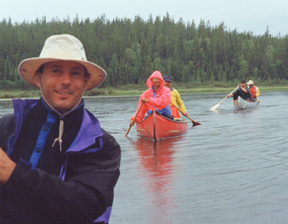
The canoeist must quickly move to the right, or west, side of the river in order to reach the portage (P4) past a long set of rapids in a narrow gorge. These rapids must be portaged. Portage Number 4 is 1375 metres long, steep in spots, and in poor condition due to windfallen trees. This portage starts at a steep bank by a distinct opening on the right, or west, shore of a narrow bay just upstream and to the right of the head of the rapids.
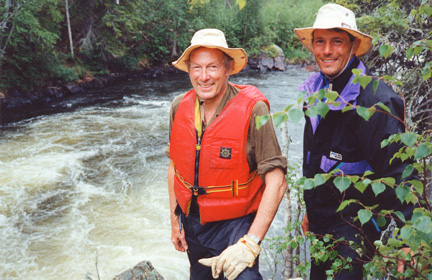
The first 275 metres (301 yards) of the trail crosses a wet marshy area, it then enters an extensive area of windfallen trees. The best option here is to cut left 200 metres (219 yards) to the river and carry or line the canoes for 500 metres (547 yards) along a Class 3 section of rapids to the foot of a 33 metre (100 foot) cliff.
We portaged around the waterfall, during which I lost my glasses (but there was not much to read anyway, except the map), then paddled down the R3, looking for the 33m. cliff. There was an aluminum canoe still folded around a rock in the rapids. We wondered how they got out since it was a long and rough way to civilization

From upstream, the aluminum canoe appeared to be a large, smooth rock. We swung into an eddy a short distance downstream from it, and we were astonished to see that the big smooth rock was an aluminum canoe, wrapped around a much smaller rock.
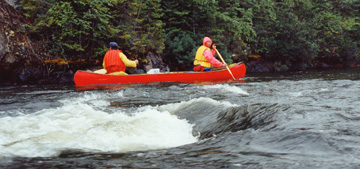
The eddy we were in wasn’t that big. With Warren and I, and then Rick and Alan in it, there wasn’t a lot of room for Brent and Mike. Brent had a brief moment of panic as he thought that they wouldn’t fit in with us. It would have been a bad thing to miss the eddy because it was hard to see very far down the rapid, and no-one really knew what was next. We had made it this far by eddy-hopping down the rapid. This is a technique where you stop in an eddy and look ahead to scout out the rapid, looking for the next eddy to pause in. In our case, since we never knew when we might encounter something unrunnable, we had to cling to the river-right shore, so that we could make it up to the portage trail when it became necessary.
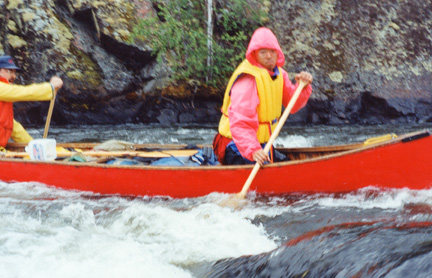
As Alan eddied out he looked anxiously at a big hole!
The rapids below this cliff are Class 4. The canoes and gear must be laboriously carried to the top of this cliff. The remaining 367 metres (401 yards) of the trail is in good condition and ends at an open grassy area 100 metres (109 yards) below the end of the gorge.
We missed the start of the portage, so we landed and hiked up through a lot of deadfalls to find the trail. We then backtracked to find the correct landing site and lined the canoes back upstream 100 m. We portaged up a very steep bank, through a forest fire area with lots of deadfalls.
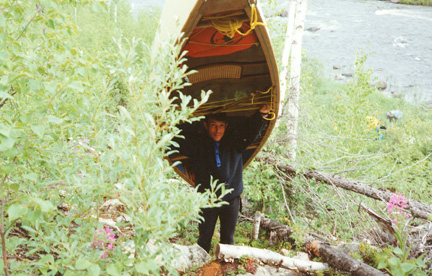
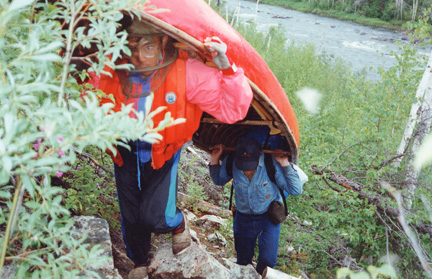
Rick had previously practiced portaging his canoe with the bow rope wrapped around a tree and repeated this here: this brought him to an abrupt stop part way up the steep slope. Indeed, he nearly fell over backwards and back down the hill. Rick turned around and gave me a hell of a glare (he assumed that I had stepped on the rope) to my innocent surprise, but to everyone else's guffaws.
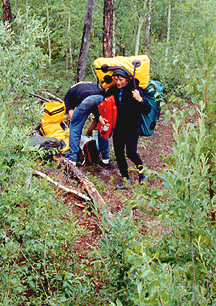
It is a macho tradition to carry two or three packs at a time along the portage trail, to save time!
The climb was followed by a long descent to put the canoes in. At the end of the trail we found discarded clothes and sleeping bags apparently from the group which lost the canoe pinned to the rock, although there was also half of a fiberglass canoe nearby. We played for a time in the eddies at the bottom of the rapids then left.
We later found out that the discarded clothes and gear were from a group of two canoes, one of which was wrecked, with both paddlers seriously injured. The other pair paddled the remaining canoe down to the Virgin River, where they paddled up to Careen Lake and an outfitter's fly-in fishing camp. They radioed for rescue and a helicopter came out and picked up the injured people. Because of the urgency and the narrowness of the river valley the gear was not retrieved.
In the 12 kilometres between this portage and the junction of the Virgin River, there are two short Class 2 rapids which should be examined prior to running. We ran the two R2s and paddled to the confluence with the Virgin River. This is where the Clearwater changes direction towards the southwest.
Novice Lesson No. 3 Rapids are beginning to be less of a confusing panic. It is surprising how much you slow down if you back paddle, which gives you time (relatively) to look ahead. (that is how I remembered it but Warren says that, as we were going down a boulder garden, the water flow was perfect for backpaddling across to another flow, but I panicked a bit in the front when he (Warren) turned the canoe into what looked like the wrong direction and said “Back paddle”. Instead of back paddling, I dug in hard forwards. He had to yell “BACK paddle” several times before I switched to back paddling. By that point, we were farther down the river than he had intended us to be. But with some hard paddling, we made past the rock. It was at that point that I realized that back paddling can do magical things, such as change lanes on the river without going downstream at all. It takes a lot of getting used to, because the canoe ends up pointing exactly where you don’t want to go.
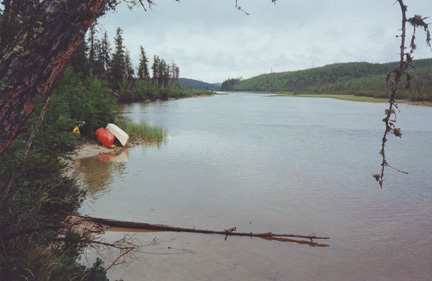
A good campsite can be found at the confluence of the Clearwater and Virgin Rivers from which a 2.5 kilometre side trip can be made to the foot of a beautiful falls in the narrow gorge which drains Careen Lake. There is excellent fishing for grayling, pike and walleye in the pools at the foot of the falls. Excellent fishing and photographic opportunities exist from the numerous foot trails which parallel the southwest side of the gorge.
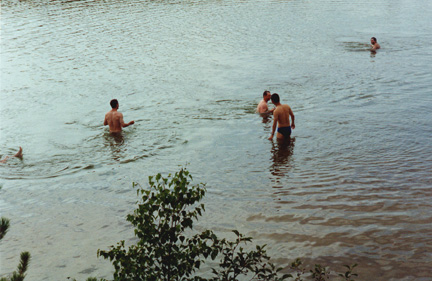
We set up camp at the junction of the two rivers. Even though we had no women along on the trip we decided to bathe! The water was cool for swimming, but there was a nice sandy beach and lake bottom.
We set the kitchen tarp (Novice Lesson No. 4: If you put the tarp up it will not rain). We found more abandoned clothes. It rained during dinner. This was not a violation of Lesson 4 since there was a design flaw in the rigging of the tarp which poured water down onto unsuspecting campers.
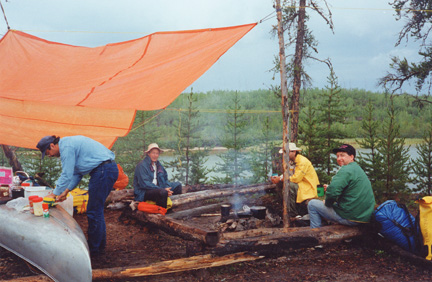
For dinner, I cooked tons of sausages (5 pan loads!) since they were at their limit of freshness, Allan cooked rice, and the non-teetotallers drank vodka and rye.
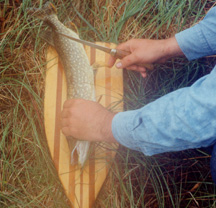 Novice Lesson No. 5
On a canoe trip you can gorge on all of the stuff like butter and fat which
is normally
bad for you, on the basis that you are burning about 4,000 calories a day.
Novice Lesson No. 5
On a canoe trip you can gorge on all of the stuff like butter and fat which
is normally
bad for you, on the basis that you are burning about 4,000 calories a day.
After dinner Rick, Warren and Brent paddled up the Virgin River to the falls and fished until dark. They only caught jack, but this time kept one. They paddled back in the dark, and found the campsite by the light of a lantern we had hung out for them.
On Day 3 we had paddled 12 km and portaged the big gorge.